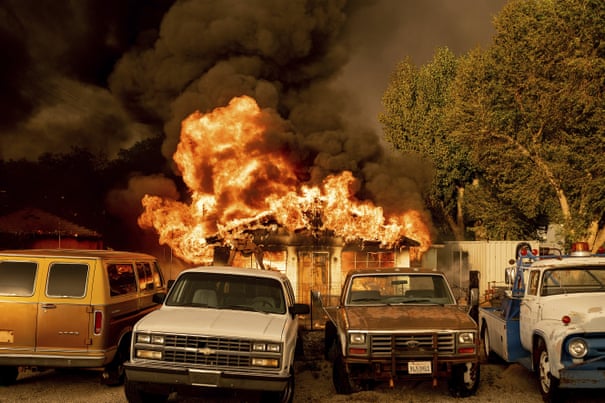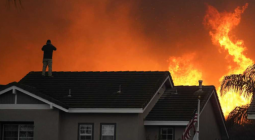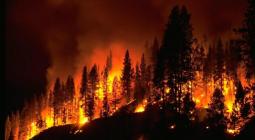Wildfires tear through 1m acres in US west as 16,000 firefighters battle onslaught

Drought and deadly heatwaves fuel flames that threaten Native American tribal lands struggling to save water.
Wildfires burning across the US west have engulfed nearly a million acres and drawn in about 16,000 firefighters and workers to battle the blazes. The onslaught comes as the region reels from intense drought and deadly heatwaves amplified by the climate crisis.
“The amount of fire, where they’re burning, and just the intensity of them is very concerning,” said Faith Kearns, a scientist at the California Institute for Water Resources.
The fast-moving Bootleg fire in southern Oregon has burned more than 200,000 acres. It has already destroyed several homes and threatens thousands more, as officials warn that tinder-dry conditions and high temperatures could exacerbate the situation on Wednesday.
Al Lawson, the fire incident commander, warned responders: “As you go out there today – adjust your reality.”
“We have not seen a fire move like this, in these conditions, this early in the year. Expect the fire to do things that you have not seen before,” he said.
Mark Enty, a spokesman for the North-west Incident Management Team working to contain the fire, said the Bootleg fire had doubled in size each day.
“That’s sort of like having a new fire every day,” Enty said.
Fire authorities have said it could take more than four months to completely contain the Bootleg fire, according to USA Today.
“The fire will continue to be extremely active in unchecked portions of the perimeter, with unstable air conditions and extremely dry fuels,” a national incident report reads, warning of “rapid fire spread with high intensity” because of the hot, dry conditions.
The fires are threatening Native American tribal lands already struggling to conserve water and preserve traditional hunting grounds in the face of drought.
In north-central Washington, hundreds in the town of Nespelem on the Colville Reservation were ordered to leave because of “imminent and life-threatening” danger as the largest of five wildfires caused by dozens of Monday night lightning strikes tore through grass, sagebrush and timber.
Seven homes burned but the entire town evacuated safely before the fire arrived, said Andrew Joseph Jr, chairman of the Confederated Tribes of the Colville Reservation that includes more than 9,000 descendants of a dozen tribes.
Monte Piatote and his wife grabbed their pets and managed to flee but watched the fire burn the home where he’d lived since he was a child.
“I told my wife, I told her, ‘Watch.’ Then boom, there it was,” Piatote told KREM-TV.
The confederation declared a state of emergency and said the reservation was closed. The declaration said weather forecasts called for possible triple-digit temperatures and 25mph winds on Wednesday into Thursday that could drive the flames.
The Bootleg fire has been creeping closer to where the Klamath Tribes – comprising three distinct Indigenous peoples – have lived for millennia.
“There is definitely extensive damage to the forest where we have our treaty rights,” said Don Gentry, chairman of the Klamath Tribal Council in Chiloquin, Oregon, about 25 miles west of the Bootleg fire.
“I am sure we have lost a number of deer to the fire,” he said. “We are definitely concerned. I know there are cultural resource areas and sensitive areas that are likely the fire is going through.”
The Klamath Tribes have been hit by wildfires before, including one that burned 23 sq miles in southern Oregon last September. That fire damaged land where many of the Klamath tribal members hunt, fish and gather. The fire also burned the tribes’ cemetery and at least one tribal member’s house, Oregon Public Broadcasting reported in September.
The tribes are struggling with drought-caused problems. In past decades, they have fought to preserve minimum water levels in Upper Klamath Lake to protect two species of federally endangered sucker fish that are central to their culture and heritage. Farmers draw much of their irrigation water from the same lake. Even before the fire erupted, extreme drought in southern Oregon had reduced water flows to historic lows.

In California, the Beckwourth Complex fire, the largest conflagration the state has seen this year, was more than 70% contained after searing through 95,358 acres near the Nevada state line.
Damage was still being tallied in the small rural community of Doyle, California, where flames swept in during the weekend and destroyed several homes.
A fire that began on Sunday in the Sierra Nevada south of Yosemite national park grew to nearly 15 sq miles but containment increased to 15%. Four unspecified buildings were destroyed.
And not far from the town of Paradise, which was leveled by the deadly Camp fire in 2018, a fast-spreading fire has grown to 1,200 acres. Officials said it was moving away from populated areas, but they would be ordering more resources to respond to the blaze in what is one of the most challenging terrains to fight fire.
So far this year, nearly 34,000 fires across the US have burned more than 2m acres, according to the National Interagency Fire Center. The wildfires have “been much in line with the seasonal predictions”, Daniel Swain, a climate scientist with the University of California, Los Angeles, said. But this year, “the explosion of wildfire activity in the north-western US is earlier and more severe than you’d expect.”
The fire season in California and the north-west was just getting started at full force, he said. “A lot of fires now burning will probably burn for a long time. And meanwhile, the drought, the extreme heat, the extreme conditions driving the fires will continue to escalate.”
Victoria Bekiempis contributed reporting
15 July 2021
The Guardian




